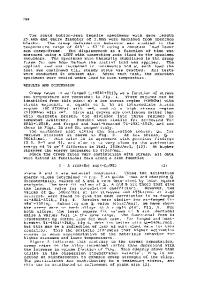Synthesis of titanium boride (TiB) 2 nanocrystallites by solution-phase processing
- PDF / 2,563,285 Bytes
- 14 Pages / 576 x 792 pts Page_size
- 19 Downloads / 302 Views
Claire A. Frey and Shankar M. L. Sastry Department of Mechanical Engineering, Washington University, St. Louis, Missouri 63130-4899
K. F. Kelton Department of Physics, Washington University, St. Louis, Missouri 63130-4899 (Received 10 April 1995; accepted 30 June 1995)
Nanocrystalline TiB2 is prepared by reaction of NaBH 4 and TiCU. The initial solution-phase reaction affords an amorphous precursor powder from which 5-100 nm TiB2 crystallites are obtained upon annealing at 900-1100 °C. Crystallite sizes depend on the annealing temperature and other processing parameters. Crystallite morphology is size dependent; crystallites smaller than 12-15 nm are cuboidal, whereas crystallites larger than 12-15 nm are hexagonal platelets. The procedure affords gram quantities of the smallest available TiB2 nanocrystallites.
I. INTRODUCTION The synthesis and complete characterization of nanocrystalline TiB2 produced by a convenient chemical method are described herein. 12 Small TiB2 precipitates with micrometer dimensions are known to improve the strength and creep resistance of titanium-matrix composites prepared by rapid-solidification processing. 36 The effectiveness of these dispersoids increases with decreasing particle size and interparticle spacing7-8; however, micrometer-sized precipitates represent the lower limit obtainable by rapid-solidification processing.3"6 Consequently, we have produced by a solution-basedprocessing route nanometer-sized TiB2 crystallites for use in metal-matrix composites. Additionally, consolidated nano-TiB 2 may exhibit greater ductility, fracture toughness, and ease of densification than conventional coarse-grained TiB 2 . Recent studies by Siegel and co-workers have shown that nanocrystalline ceramics (specifically TiO2 and ZnO) have greater ductility and densify more efficiently and at lower temperatures than do their coarse-grained counterparts.9"11 Thus, nanocrystalline TiB2 may be more readily formable, and may consolidate to high densities, thereby affording increased toughness without sacrifices in strength and hardness. The currently favored method of producing nanocrystalline materials is the gas-phase condensation technique developed by Siegel,12'13 Gleiter,14 and others. This method requires sophisticated reactors, appears to be limited to oxide compounds among ceramic materials, and to date has produced only small quantities of materials. In contrast, we are developing solutionphase-processing strategies that use common reagents J. Mater. Res., Vol. 10, No. 10, Oct 1995 http://journals.cambridge.org
Downloaded: 11 Mar 2015
and simple apparati, are amenable to large scales, and are potentially applicable to a wider range of ceramic and other materials. Although gas-phase condensation may have advantages in reduced surface contamination and other aspects, solution-phase processing may prove to be more viable for the large-scale production of nanocrystalline materials.15 In this paper we describe the adaptation of a known chemical synthesis1'2 of TiB2 to the preparation of gram
Data Loading...











